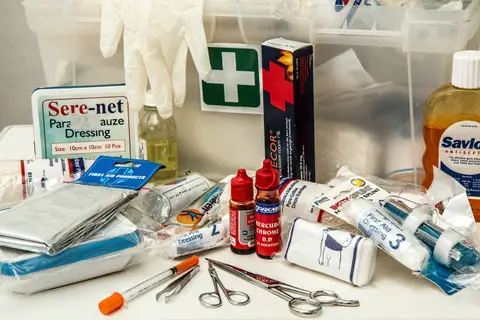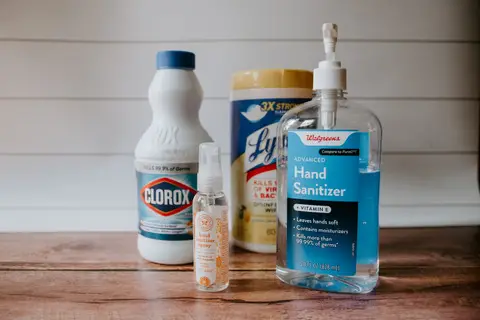Essential Items to Have in Your Emergency Bag
It’s always a good idea to plan for unexpected events. Whether you’re preparing for wilderness survival or a natural disaster, having the necessary supplies to get you through emergency situations is vital.
Preparing an emergency bag can potentially mean the difference between life and death depending on the situation. Because emergencies can happen at any time, it is recommended that you create one emergency bag that is portable in case you are required to evacuate your home and another which is kept permanently in your home in case you are forced to remain there for an extended period.


We often take things like electricity, running water, and access to food and services for granted, but what if any of these things was suddenly not available? Would you be able to survive? Packing an emergency bag will allow you to become more self-reliant and prepared in times of crisis. At a minimum, your emergency bag should contain enough food, water, and other essentials to get you through three days without outside assistance.
While each emergency bag will be a bit different depending on what you are preparing for, there are a few items that should be included with every emergency survival kit. In order to help you start creating your own personalized emergency bag or kit, we have gathered up the top ten survival items you will definitely want to include.


First Aid Kit
Every emergency bag should contain a basic first aid kit. You need to be able to attend to basic medical needs when professional medical assistance may not be available. You can easily customize a first aid kit to be better suited for the situation you may need it for. For example, a first aid kit designed for camping or multi-day nature treks will look a bit different to the one you keep in your home in case of natural disasters.
Every first aid kit should contain the essentials like pressure immobilization bandages, adhesive bandages, rubbing alcohol, hydrogen peroxide, tweezers, medical tape, eye drops, and disposable gloves. You can add in things like a snake bit kit, insect sting cream, and an EpiPen for your wilderness first aid kit.
Don’t’ forget to include a first aid manual to guide you through how to treat various ailments like broken bones, dehydration, hypothermia, and heat exhaustion. It is also a great idea to take a first aid class which will teach you life saving skills such as CPR and the Heimlich maneuver.

Water
Staying hydrated is crucial in any survival situation. When events like natural disasters strike, safe drinking water may not be available through your tap. You need to make sure you have a supply of clean water on hand that will keep you alive until you gain access to fresh water once again. Without adequate water consumption, your organs and normal bodily functions are put at risk.
Our bodies are made up of at least 60% water and adults require roughly 100 ounces of water every day to stay healthy. For drinking and sanitation in emergency situations, you should store at least 1 gallon of water per person in your family or group per day for a minimum of three days, two weeks if possible. For times when you cannot carry or store an appropriate amount of fresh water such as on long wilderness treks, you will need to have some way of purifying water. This can be done through boiling, purification tablets, or purifying devices such as LifeStraws.
Commercial bottled water is the easiest and safest fresh water to store. If you plan to store water from another source, be sure to use FDA-approved food-grade storage containers.

Food Packets
Alongside having enough water, having an appropriate amount of food is equally as important to keeping you healthy. Adult bodies generally require a minimum of 1,200 calories per day to remain in good health. You should store non-perishable food items like canned food that doesn’t require cooking in your emergency kit. Like water, you should have a minimum three day supply on hand and don’t forget to pack a manual can opener.
The outdoor experts at https://thepreppingguide.com/what-is-prepping/ suggest storing non-perishable food packets that can have a shelf life of 5-10 years. Known as MREs (Meals, Ready-to-Eat), food packets contain long life food that is often dehydrated and freeze dried. While they may not be the most delicious meals, they will provide you with the necessary nutrition and there are options available that cater to various allergies such as people requiring a gluten-free diet.
Babies’ nutritional needs depend on their age and may require a combination supply of breast milk, formula, and solid foods. You also don’t want to forget about stocking enough food for your pets. Having an adequate supply of food on hand means you won’t go hungry during a natural disaster, pandemic, or outing in the wild.


Flashlight and Fire Starter
In case of blackouts or the need to evacuate at night, you may need a flashlight in order to navigate or perform essential tasks in the dark. We take for granted the ease of simply flicking a switch to light a room, but in certain emergency situations, electricity may not be available.
You should pack a bright LED battery-operated flashlight with plenty of spare batteries. A good backup option to have is a solar-powered or hand-crank-powered flashlight. A durable waterproof flashlight is recommended for outdoor survival situations.
A fire can also provide light as well as allowing you to cook food and purify water. In order to be able to start a fire, include waterproof matches, a lighter, or flint in your emergency kit.


Cash and Important Documents
During some emergency events, goods and services may still be available for purchase. However, you may not always be able to rely on your credit cards for payment. There are many instances where credit card processors go down and businesses are forced to only accept cash. You should always have a stash of physical cash on hand that can last you at least a week in case of a natural disaster or other emergency.
You should also have access to important documents such as your passport, local IDs, insurance documents, birth certificates, immunization records, etc. While it may not be practical or wise to keep originals of all your important documents in your emergency bag, you can pack certified copies of these documents in your emergency kit. Alternatively, you can store electronic copies of important documents on a USB or online cloud drive.


Medications
Another essential to include in your emergency bag is a supply of any essential medications you are currently taking. During an emergency, you may not be able to acquire the medications you require as easily. You should also pack non-prescription medications such as pain relievers and anti-diarrhea medication.
If you require eyeglasses or contact lenses, be sure to include a spare set or sets in your emergency kit. You will also need to have a supply of lens solution if you wear contact lenses. Don’t forget to include any medications that your pets may require.
Radio
Stay informed during natural disasters and other emergencies with a radio. When disasters strike, power loss means having no access to TV or internet news and updates. Cell signals may also be interrupted. A battery-operated, solar-powered, or manual-crank radio will allow you to gain access to safety advice that is being broadcasted.
Radios not only allow you to get regular AM/FM radio broadcasts, but also NOAA emergency broadcasts as well. It’s a good idea to mark down what your local news radio frequencies are beforehand.

Essential Toiletries
While toiletries may not be essential to survival, it’s important to be able to stay on top of hygiene and make yourself as comfortable as possible. You should include in your emergency bag various toiletry items you regularly use on a daily basis such as soap, toothbrush and toothpaste, feminine products, and toilet paper. Don’t forget items for your baby such as diapers, wipes, and diaper rash cream.


Disinfecting Products
Along with toiletries, your kit should also contain disinfecting cleaners. Being able to fight bacteria and viruses is important because things like E. coli and Salmonella can make you very sick. Having access to hand sanitizer and antibacterial cleaners will help keep things clean and hygienic whether you’re facing an emergency in the wild or at home.
The EPA even states that you can disinfect water using regular, unscented chlorine bleach products that are suitable for disinfection and sanitization as indicated on the label. This can come in handy when an emergency such as flood or hurricane disrupts regular water service. It is important to research exactly how much bleach you should add to water to disinfect it without making it harmful to your health. This usually involves adding just a few drops of bleach per liter of water. For more detailed information on disinfecting water with bleach, we encourage you to read the CDC’s guidelines.

Basic Tool Kit
Having a small selection of basic tools is also a good idea in case of emergencies. A simple multi tool or Swiss Army knife will provide you with a number of basic tools you may need. You may also want to pack a roll of duct tape or rope. Customize your tool kit depending on what you need your emergency bag for, whether that be wilderness camping or preparing for a natural disaster. You may also want to think about preparing a roadside emergency kit in order to make basic repairs to your vehicle if required.

Preparing an emergency bag will help ensure you can survive during events such as natural disasters until essential services are restored. Be sure to check on and update your emergency kit regularly, replacing any items that may have expired.
Equally as important as knowing what to pack in your emergency bag, is of course the bag itself. We recommend purchasing a high quality bag like those offered by Tucker & Bloom whether you’re considering a backpack, messenger, or duffel style bag.
Store your emergency bag in a cool, dry place and have a designated spot so that everyone in your household knows where to find it. In addition to keeping an emergency bag in your home, you may also want to think about preparing additional emergency bags for your workplace and vehicle for added safety assurance.
Lastly, have an evacuation plan in place in case you need to follow it and always take out insurance to protect yourself financially in times of crisis.



















